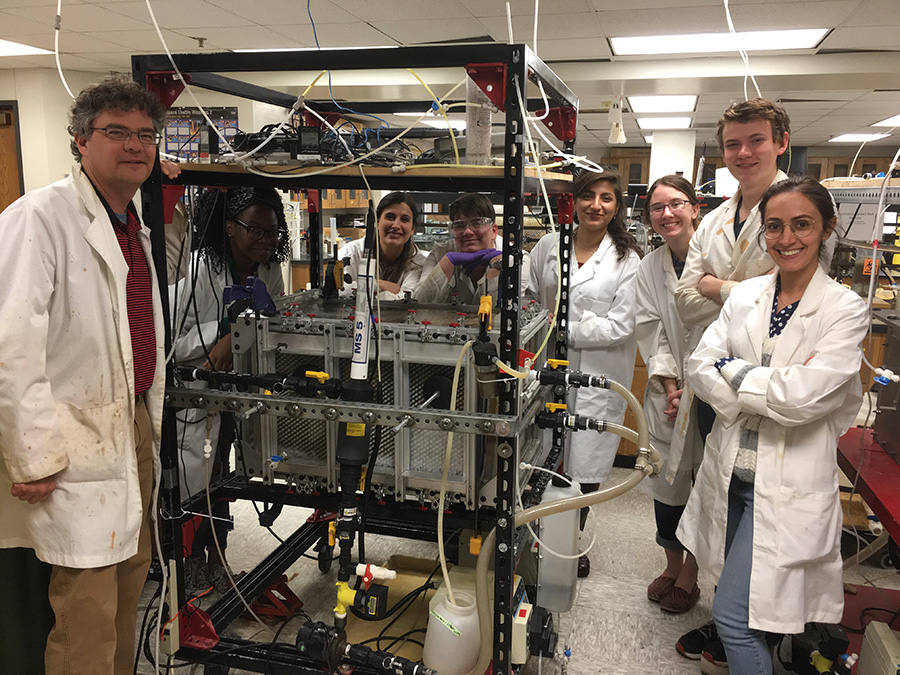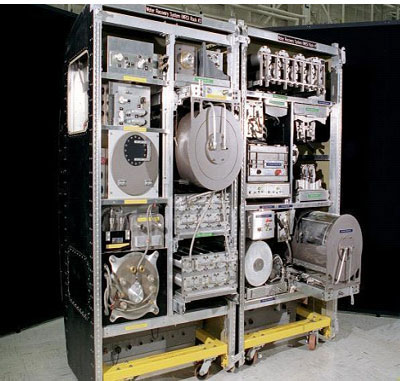Researcher Developing Water Recycling System for Longer Space Missions
By: Crystal Price

Space travel is becoming more of a reality and less like a tale out of a science fiction novel. In just a few years, the human race will hopefully revisit the moon and journey to Mars.
One of the main hurdles of space travel is water. The human body requires water to survive, but how do you keep it flowing in deep space?
W. Andrew Jackson, a President's Excellence in Research Professor in the Edward E. Whitacre, Jr. College of Engineering, Department of Civil, Environmental, and Construction Engineering, is researching the question of how to make a life support system more sustainable in space.
The International Space Station (ISS) has been using the same water recycling system for around 10 years and has recycled more than 43,000 pounds of water to date. Even though this complex device works really well, a lot can go wrong.
When a part gives out, many replacement pieces are readily available, and new stock can be flown up to the ISS on a future mission. However, this is not possible for missions to the moon and Mars. A simpler, less complex option is necessary.
Launching water from Earth is very expensive; one bottle of water costs about $30,000, so sending all of the water required for a mission to Mars is not possible. Instead, wastewater produced by the astronauts must be treated and recycled to provide drinking water.
The ISS currently uses a closed-loop system in which wastewater, such as urine, sweat, or condensation, is captured and then filtered, leaving potable water.
This water can then be used for human consumption, whether it be drinking, rehydrating food, or bathing. The system may sound disgusting, but the recycled water aboard the ISS is actually cleaner than what humans consume on earth.

Jackson says, "To date, NASA has had a very successful water recycling program on the ISS, but it's a completely physical and chemical process which requires consumables and a lot of up mass in replacements such as filters and chemicals. We've tried to introduce the idea that incorporating biological treatment would make the systems more sustainable and less mass intensive."
Jackson is working to develop biological reactors that could be used as part of an overall water recycling system to reduce reliance on Earth as well as reducing the amount of mass aboard the habitat.
"In something like a three-year mission to Mars, you want to have as few consumables as possible. Bringing water is just not an option," Jackson states. "We must find a way to control the reactor independent of other systems, contain the biohazardous waste, and test the reactor in micro-gravity environments."
Two gravitational forces need to be considered during the testing phase. One is microgravity, which is very weak gravity, and two is reduced gravity, which is an environment where the gravitational field is less than that of the Earth, such as the lunar surface.
The ISS provides a microgravity environment to test Jackson's bioreactors. Testing in an appropriate environment is important because what is flown on a test flight on the ISS looks and acts differently than what is tested on Earth.
Currently, this biological system is not designed as a standalone, but is partnered with other systems making any water infrastructure for habitation less mass intensive.
Jackson says, "Less mass is always better in a microgravity environment. However, any technology and especially new technologies can have issues and reliability is one of NASA's top priorities."
As with all research, Jackson's bioreactor still has some stumbling blocks to overcome. Mainly he wants to demonstrate the system is reliable and can be started up in a short period of time, as well as demonstrate the system will not cause problems with downstream systems due to loss of biomass.
Jackson hopes for about one more year of ground development before he hands over a prototype and protocol to then be analyzed and put in sequence for a test flight.
Other research that Jackson is involved with includes work with Paragon Space Development Corporation to develop a bioreactor with Nafion-based technology. Nafion is a brand name for a synthetic polymer with ionic properties. This technology would allow water vapor to move across a membrane creating almost potable water by the time it condenses back out.
He is also working with Pancopia to develop and test anammox bacteria. This bacteria eats ammonia and breathes out nitrate, which can be converted back to nitrogen gas that can then be used as a consumable.
Jackson says that Texas Tech is now known as "the group" for biological life support, which means privatized groups reach out to the university to see if there is a match for development and testing.
Jackson has worked with NASA since Texas Tech began partnering with them in the early 2000s and hopes this valuable partnership lasts for many years to come.
Photo on index page courtesy of the NASA's Marshall Space Flight Center's YouTube video.
Discoveries
-
Address
Texas Tech University, 2500 Broadway, Box 41075 Lubbock, TX 79409 -
Phone
806.742.3905 -
Email
vpr.communications@ttu.edu
